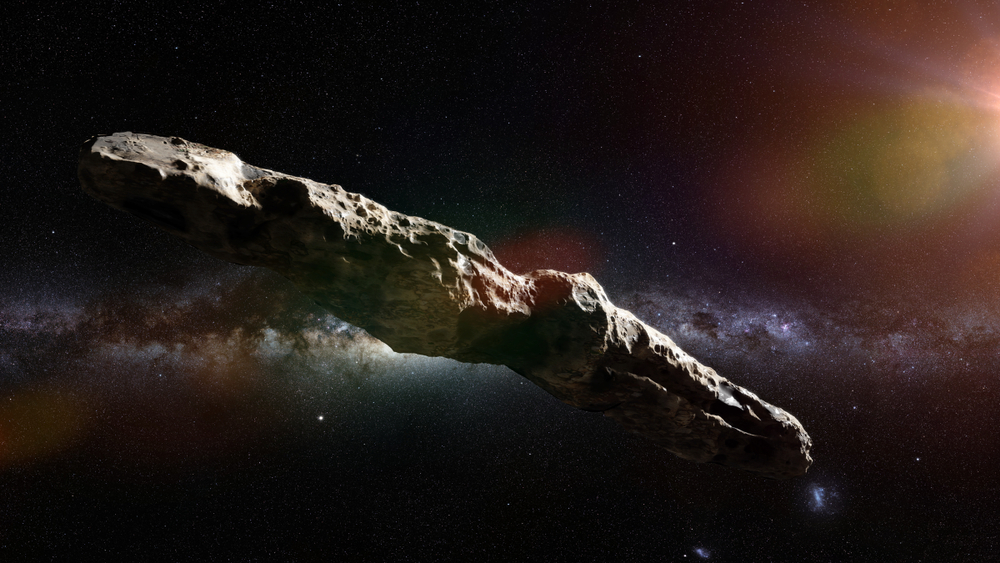Scientists Are Still Trying to Explain Mysterious Space Object ‘Oumuamua’s Odd Behavior
Posted on Categories Discover Magazine

Since astronomers first laid eyes on the interstellar object known as ‘Oumuamua in October of 2017 at the Pan STARRS telescope in Hawaii, it’s strange behavior and mysterious origins have sparked speculation and debate. The interstellar object appears to have originated from outside of our solar system.
‘Oumuamua Meaning
The unique ‘Oumuamua name was given by the International Astronomical Union after the Hawaiian phrase “a messenger from afar arriving first.” And nearly five years after its discovery, the object continues to baffle astronomers for its odd motion and appearance.
It’s not uncommon for interstellar objects to enter our solar system. The formation of planetary systems like our own can be pretty chaotic, and these processes can send large quantities of rock and other debris hurtling through space for millions of years. Astronomers call these objects planetesimals.
What Is ‘Oumuamua Exactly?
‘Oumuamua was thought to be just another one of these fragments. Typical planetesimals aren’t dissimilar to comets that form at the edge of the solar system, but observations quickly showed that something wasn’t quite right.
For starters, it didn’t look like a comet and instead has an elongated, flat shape. What’s more, it didn’t have other distinguishing features of comets, like a tail or the fuzzy envelope called a coma — both composed of gas and dust.
Alien Asteroid?
‘Oumuamua looked like an asteroid. Following its discovery, most of the world’s major observatories collected data on ‘Oumuamua, until it became too faint for our most powerful telescopes. A number of far-flung hypotheses were put forward to explain its composition, and possible origins, including that it could be an extraterrestrial craft.
Read More: How the James Webb Space Telescope Will Search for Extraterrestrial Life
‘Oumuamua Trajectory
In a new paper published in Nature, astrophysicists Jennifer Berger and Darryl Seligman put forward an explanation for the peculiarities of ‘Oumuamua. The researchers propose a model that explains ‘Oumuamua’s acceleration as a result of the loss of hydrogen gas from its surface.
The idea has been suggested before, but the novelty of Bergner and Seligman’s analysis stems from how the researchers explain how the hydrogen got inside the object in the first place.
Gravity and Motion
‘Oumuamua moved through space mainly as a result of gravity. But its motion couldn’t be explained by gravity alone; it was accelerating, similar to comets that accelerate due to their continual loss of gas and dust. The conundrum: How was ‘Oumuamua speeding up with no apparent loss of material?
Was ‘Oumuamua a Comet?
The authors suggest ‘Oumuamua was born in its home planetary system as a water-rich planetesimal, resembling a comet. As it traveled through interstellar space, it was constantly irradiated by galactic cosmic rays, causing the water molecules to dissociate and produce molecular hydrogen.
This molecular hydrogen remained trapped in the frozen body of the object until it started to heat up as it approached our sun. As it heated, the ice changed its structure, releasing the trapped molecular hydrogen as a form of fuel, causing ‘Oumuamua to rocket through our solar system.
Hydrogen and Ice
In their analysis, Bergnber and Seligman show that there is enough ice under the object’s surface to create the molecular hydrogen — and that it could have gotten hot enough to release the gas necessary to explain its acceleration.
Crucially, their theory doesn’t require a volume of lost hydrogen that could be visible from Earth. Thus, they conclude, ‘Oumuamua appeared inactive while emitting enough hydrogen to propel it through space.
Non-Gravitational Forces
But then why don’t we see similar non-gravitational forces acting on the thousands of comets we have observed in the solar system so far?
According to the researchers, such an effect seen in ‘Oumuamua is a surface effect, where the sun’s heat only penetrates the surface slightly. So, the larger the object, the less powerful the effect becomes. ‘Oumuamua, with a diameter of roughly 330 feet, is a lot smaller than regular comets which often span miles in diameter. Future observation of comets similar in size to ‘Oumuamua should help astronomers know if they’re on the right track.
Read More: Alien Space Rock ‘Oumuamua May be Chunk of a Shredded World
An Ongoing Debate
Still, not everyone in the astronomical community is convinced. Avi Loeb, an astronomer from Harvard University, believes Bergnber and Seligman made a mistake when calculating the surface temperature of ‘Oumuamua.
Surface Temperature
In a draft of a new paper, Loeb says that the original surface temperature calculation ignores a significant cooling effect generated by the evaporating hydrogen, and that by adding this cooling effect, it decreases the surface temperature of ‘Oumuamua by an order of magnitude.
“They balanced the heating by sunlight with cooling by radiation to get the surface temperature of their hypothesized iceberg but forgot about the energy that needs to be invested in liberating the hydrogen molecules from the lattice [the icey body of the object],” says Loeb.
“Unfortunately, after incorporating the correct formula, we get a surface temperature that makes the proposed model untenable for explaining the non-gravitational acceleration of ‘Oumuamua,” he adds.
Supernatural Origins
Loeb himself caused a stir when he suggested that ‘Oumuamua could be artificial in origin. Nonetheless, other theories describing ‘Oumuamua in purely natural terms have run into significant problems, as well.
Given the anomalies associated with the object and the opinions that have been made publicly by scientists, it will no doubt continue to be a topic of debate among astronomers.
Read More: Interpreting 5 Ancient Constellations Across Cultures